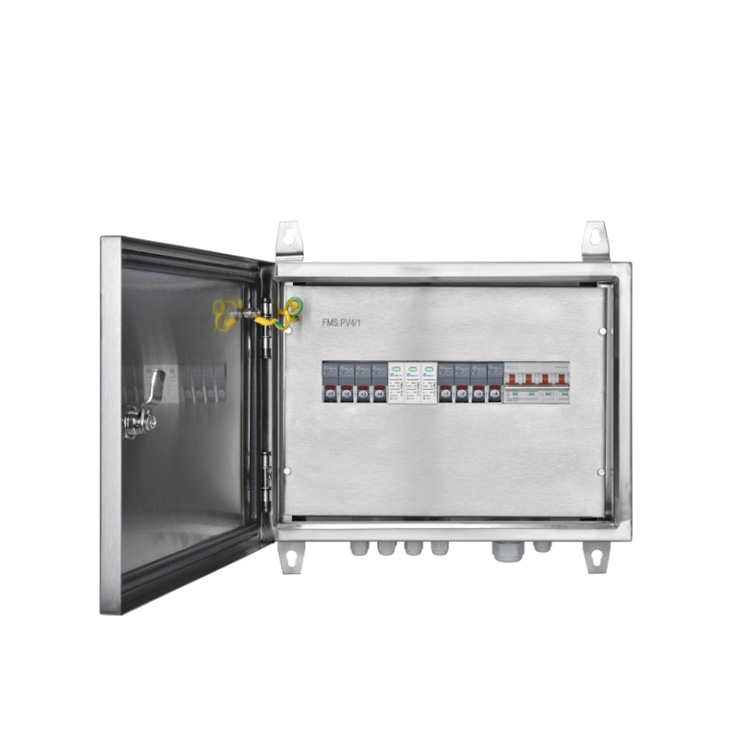Understanding the Role of a Combiner Box in Solar Energy Systems
2025-01-04
As renewable energy solutions become increasingly popular, solar power is leading the charge as one of the most reliable and sustainable energy sources. Whether you're installing a solar system for your home or business, there are several critical components that ensure your system operates efficiently and safely. One of these key components is the combiner box. In this blog, we'll explore what a combiner box is, its functions, and why it's essential for solar energy systems.
What is a Combiner Box?
A combiner box is a vital piece of electrical equipment used in solar energy systems to combine multiple solar panel strings into a single output. Essentially, it acts as a central hub where the electrical connections from individual solar panel strings are brought together before being sent to the inverter. It ensures that the current from each string is safely and effectively combined and transmitted to the next stage of the system.
Combiner boxes are typically equipped with fuses, disconnect switches, and other protective devices to ensure the safety and proper functioning of the system. Depending on the size and design of the solar installation, a combiner box can handle multiple strings of solar panels, making it an essential part of a scalable solar power system.
Key Functions of a Combiner Box
1. Combining Multiple Solar Panel Strings
The primary function of a combiner box is to bring together the power generated from multiple strings of solar panels. In a typical solar installation, individual solar panels are grouped into strings, which are essentially collections of panels wired together in series. Each string produces direct current (DC) power, and the combiner box combines these outputs into a single DC output that can then be fed into the solar inverter. This centralization simplifies wiring and helps keep the installation more organized.
2. Overcurrent Protection
Solar energy systems are designed to operate within a specific range of current, and excessive current can damage electrical components or create safety hazards. Fuses or circuit breakers in the combiner box provide overcurrent protection for each solar string. If the current from any string exceeds a safe limit, the fuse or breaker will trip, disconnecting the affected string and preventing potential damage. This feature is critical in maintaining the overall safety and longevity of the solar system.
3. String Monitoring and Isolation
Many modern combiner boxes come with monitoring capabilities that allow system owners to track the performance of individual solar strings. Monitoring can help identify underperforming strings or faults in the system early on. In addition, disconnect switches in the combiner box allow each string to be isolated from the rest of the system for maintenance or troubleshooting, without needing to shut down the entire solar installation.
4. Grounding and Surge Protection
A combiner box typically includes grounding options for each solar string. Proper grounding is essential for preventing electrical shock hazards and ensuring the safety of the system. Many combiner boxes also feature surge protection devices that help protect the system from power surges or lightning strikes, which can cause significant damage to sensitive electrical components.
Why is a Combiner Box Essential for Solar Systems?
1. Safety and Protection
The combiner box plays a critical role in safeguarding the solar energy system by providing protection from overcurrent, short circuits, and electrical faults. It also isolates faulty strings from the rest of the system, preventing damage to the inverter and other sensitive components. By incorporating fuses, disconnects, and surge protection, the combiner box helps to minimize risks and ensure the long-term reliability of the system.
2. Efficient Power Distribution
By combining the outputs of multiple solar panel strings, the combiner box streamlines the process of distributing power to the inverter. This centralization reduces the complexity of wiring, which can be particularly helpful in large-scale solar installations where managing multiple panel strings individually could become cumbersome. A well-organized system with a combiner box allows for more efficient energy flow and reduces the chances of wiring errors.
3. Simplified Installation and Maintenance
The combiner box makes the installation process simpler by providing a central point for all solar panel connections. Instead of running individual wires from each solar panel string to the inverter, the combiner box allows the installer to group and route the connections more efficiently. Additionally, with built-in disconnects and monitoring features, maintenance and troubleshooting become easier, as technicians can isolate individual strings or identify faults remotely.
4. Scalability and Flexibility
A combiner box makes it easier to scale up a solar system as energy needs grow. If more solar panels are added to the system, the combiner box can handle additional strings, providing flexibility in expanding the solar installation without needing a complete redesign. Whether you're installing a system for a small residential home or a large commercial building, the combiner box can adapt to various system sizes and configurations.
Types of Combiner Boxes
1. Standard Combiner Boxes
These are the most basic type of combiner box, which simply combines multiple strings of solar panels and includes the necessary protection devices like fuses or circuit breakers. Standard combiner boxes are ideal for smaller solar systems where advanced features such as monitoring or remote control are not required.
2. Smart Combiner Boxes
Smart combiner boxes are equipped with monitoring and communication capabilities, allowing system owners and operators to track the performance of each string. These boxes often connect to a cloud-based platform or mobile app, providing real-time data on energy production, system health, and potential issues. They are ideal for large, complex solar installations that require detailed performance tracking.
3. Commercial and Utility-Scale Combiner Boxes
For larger commercial or utility-scale solar installations, combiner boxes can be designed to handle many more strings and provide more robust protection features. These boxes are typically designed for high-capacity systems and may include features like high-voltage protection, sub-panels, and advanced circuit breakers. These boxes are engineered to meet the specific needs of large-scale solar farms or industrial applications.
How to Choose the Right Combiner Box
When selecting a combiner box for your solar energy system, there are several factors to consider:
1. System Size: Ensure the combiner box can handle the number of solar strings in your system.
2. Voltage Rating: Choose a combiner box that is compatible with the voltage output of your solar panels.
3. Protection Features: Look for a box that includes overcurrent protection, disconnect switches, and surge protection.
4. Monitoring Capabilities: For larger systems, consider a smart combiner box that allows you to monitor the performance of each string.
5. Weatherproofing: If the combiner box will be installed outdoors, ensure it is weather-resistant and rated for outdoor use.
Conclusion
A combiner box is a crucial component in any solar power system, serving to centralize connections, enhance safety, and streamline the flow of electricity. By combining multiple solar panel strings into a single output, providing overcurrent protection, and offering ease of maintenance, the combiner box ensures that solar systems operate efficiently and reliably.
As solar energy systems grow in complexity and scale, the combiner box will continue to play an essential role in making solar power more accessible, cost-effective, and safe. Whether you’re installing a small residential solar array or managing a large commercial solar farm, understanding the function and importance of a combiner box is key to ensuring the success and longevity of your solar installation.



